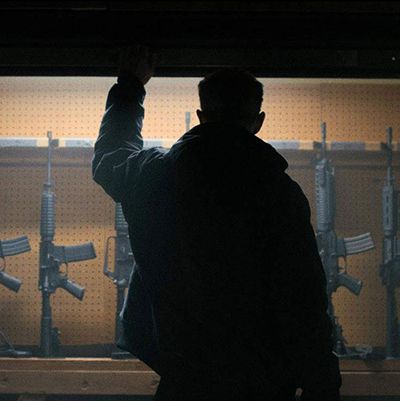
I’m overselling it wildly, but The Standoff at Sparrow Creek feels like what might happen if David Fincher shot a variation on Reservoir Dogs written by Rod Serling. Somehow both chasmic and claustrophobic, chatty yet somber, Henry Dunham’s film presents a series of mind games that might as well be taking place at the end of the world. It’s an effective little thriller whose occasional flaws come mostly as a result of its considerable virtues, so you roll with it.
The vast bulk of the story takes place inside a dark, cavernous warehouse used by seven members of an unnamed midwestern militia. They’ve all just heard over the radio and police scanners that an unnamed, Kevlar-wearing shooter armed with a modified AR-15 and a load of explosives has opened fire at a police funeral. This means the cops will be scouring the countryside, raiding any known militia groups in the vicinity. The men’s worry soon turns to panic when they discover that one AR-15 is missing from their own impeccably organized stockpile, along with a bunch of Kevlar and explosives. That makes one of them the shooter.
But which one? Ford (Chris Mulkey), the group’s grizzled, no-nonsense leader, enlists fellow member Gannon (James Badge Dale), a former police interrogator, to question the men and determine the culprit. But the terse, brooding Gannon knows something the others don’t — that one member, Noah (Brian Geraghty), is an undercover cop. Although Gannon has renounced his past, he is curiously protective of Noah, whom Ford seems to distrust from the get-go. So the former cop tries to eke out a confession from the others, while also making sure that nothing happens to Noah.
It’s a solid setup for a whole host of psychologically tense dialogue exchanges, as Gannon delves into the men’s pasts, and uses different tactics with each one. Morris (Happy Anderson), for example, has a chip on his shoulder about the police, and Gannon tries to uncover the source of that anger. Keating (Robert Aramayo), meanwhile, is a young, hulking, hyperintelligent mute with a marked-up copy of The Catcher in the Rye in his possession; Gannon senses an egomaniacal streak in the kid and tries to toy with his feelings of superiority.
Writer-director Dunham is smart enough to keep the interrogations from getting repetitive. He also layers the dialogue exchanges in such a way as to call Gannon’s own goals into question: Is he looking for the truth, or is he merely looking for a confession? Meanwhile, the urgency of the situation builds, as we hear over the police scanners that more militia attacks against cops are happening across the country. The shooter, whoever he is, has apparently inspired the beginnings of a grisly armed revolution — one that we never see, which adds to the film’s dead-end atmosphere.
The chief pleasure of Standoff at Sparrow Creek lies in watching this sharp group of character actors seize the spotlight, at least for a little bit. James Badge Dale has been a familiar face in any number of bigger releases over the years (he was the highest-grossing actor of 2013, by my calculations), and he gives Gannon a quietly unreadable but nevertheless compelling intensity. That comes in handy, as he is the one character about whom we probably know the least — rare for a protagonist. Patrick Fischler (whose profile has risen in recent years, but who will never not be the guy who dreamed about the Evil Hobo in Mulholland Drive) is fascinating as the slightly obsessive, mousy Beckmann, who handles most of the group’s radio communications, and thus has to regularly deliver information from the outside world into this hermetically sealed environment.
And director Dunham films that environment effectively, going to town with the ominous, backlit wide shots, while also making sure that each corner of the warehouse has its own distinct geography and mood. The vast stretches of darkness — probably the result of budgetary concerns as much as aesthetic ones — elevate the uncertainty. As a result, Sparrow Creek offers just enough variation and never gets visually tedious, despite taking place pretty much entirely in one location.
That the actors are so good, and the imagery absorbing, also helps paper over some of the film’s weaker elements. Even as we dig into these men’s pasts, Dunham wants to maintain the slightly unreal, allegorical quality of his story. That means leaving the whole militia angle somewhat vague. These men have checked out of society, and have renounced authority; we get that. But it’s hard not to wonder what their overall aims are, and about the extent to which they’ve committed to those goals — especially since so much of the narrative is predicated on the idea of preserving their group. At times we wonder why any of them would give a damn about the others in the first place — part of that paranoia is intentional, probably, but it does backfire at times, making us wonder about the movie’s whole premise. We learn a lot of little things, while the bigger questions go unanswered. Even so, The Standoff at Sparrow Creek makes for a memorable feature directing debut, and offers a fine chance for a few of our most underrated actors to shine.


